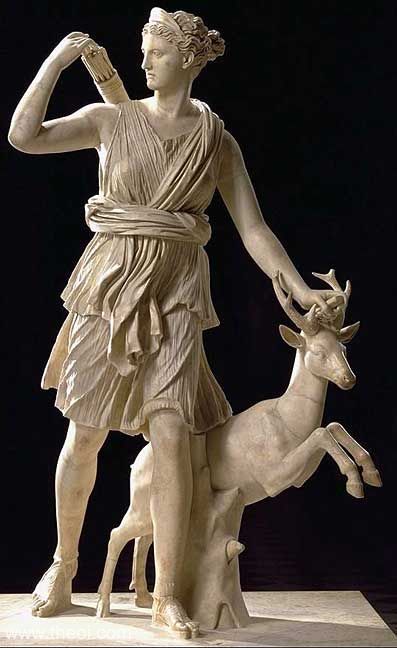You are currently browsing the tag archive for the ‘huntress’ tag.
Kindly accept my apologies for the lack of posts on Thanksgiving week: I was hunting and feasting in wild forested hills far away from the city (and my computer).
When writing about mythology, this blog traditionally concentrates on stories of the underworld and the dark beings and divinities which exist beyond the mortal veil. However to celebrate the wild joys of the forest, I am dedicating this week to Artemis/Diana–goddess of the hunt and protector of animals. Even though Artemis was primarily a virgin goddess of unspoiled wilderness, wild creatures, and of hunters and hunted, she had a dark underworld aspect as well. In stark opposition to her role as protector of children and women in childbirth she was a plague goddess who killed swiftly with afflictions which struck like divine arrows.
Artemis was the twin sister of glorious Apollo. Both siblings were the children of Zeus and Leto (a daughter of obscure Titans). Hera/Juno was angry about Zeus’ philandering and tried to prevent the birth of the twins by cursing the land they were born in, but Leto found a floating Island, Delos, which escaped Hera’s wrath by being unmoored. After the birth of the twins, Delos was cemented to the seafloor and became a sacred location.
Artemis was the elder twin. Although Leto bore Artemis quickly and painlessly, Apollo’s birth was a terrible ordeal of prolonged painful labor which lasted nine days and nights. By the end of this time, Artemis had grown into a full goddess and she helped her mother bring her twin into the world—hence her connection with childbirth. Thereafter Artemis was identified with the moon and the wilderness while Apollo has always been a sun god associated with civilization and society. When Artemis met Zeus she asked to always remain a virgin and a loner, a request which the king of the gods quickly granted to his lovely daughter.
Artemis had several attributes: a bow and a quiver full of arrows, a knee-length tunic, and packs of attendant hounds and nymphs. The sacred animal of Artemis is the deer, and she is often portrayed caressing a deer, being carried in a chariot drawn by deer with golden antlers, or hunting stags in the forest. One of Hercules’ most challenging labors was to capture a golden-antlered hind sacred to the goddess. The magical deer could outrun arrows (and anyways Heracles knew that shooting it would bring him the disfavor of the goddess and disaster). For a year he unsuccessfully pursued the deer on foot and he only succeeded in catching the doe when he fell down in desperation and groveled before the goddess (who transferred her wrath to Eurystheus). Another myth involving deer and Artemis does not end so well for the mortal protagonist. Once when she was bathing–nude, chaste, and beautiful—she was accidentally spotted by the unlucky Theban hunter Actaeon. In fury that a mortal had espied her loveliness, she transformed the hunter into a stag, whereupon he was torn to shreds by his own dogs–which did not recognize their master or know the anguished voice trying to call them off with the tongue of a deer. For some reason this scene is a timeless favorite of artists!
This last story hints at Artemis’ dark aspects. When wronged, Artemis was a fearsome being and her wild vengeance rivals that of any underworld deity. Several of the more troubling stories from classical myth involve her wrath. For example, her anger led directly to the Caledonian boar hunt, the defining heroic event of the era just prior to the Trojan War. One year King Oeneus of Calydon disastrously forgot to include Artemis in his annual sacrifices. To punish the King, she sent a monstrous male pig, a scion of the primal monster Echidna to ravage the countryside. This in turn brought the greatest hunters and heroes of Greece together with sad consequences. In other tales Artemis was even more direct with her vengeance. She visited plague upon Kondylea until the citizens adjusted their worship of her. She famously slew the many daughters of Niobe with painless arrows and turned their mother into a weeping stone.
Artemis is a self-contradicting figure–a virgin who was the goddess of childbirth; a protector of wild animals who was also goddess of the hunt; and a friend to maidens, mothers, and children who wielded the plague to smite down mortals. Her temples were frequently on the edge of civilization—at the end of the croplands where the forest began or at the edge of useable land where terra firma gave way to swamps and morasses. This highlights the main fact about Artemis—she was a nature goddess. wildness and inconsistency were parts of her. Worshiping Artemis was how the Greeks venerated and sanctified the savage beauty and random gore of the greenwood.




